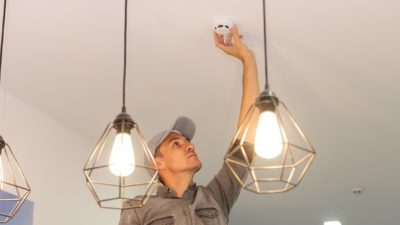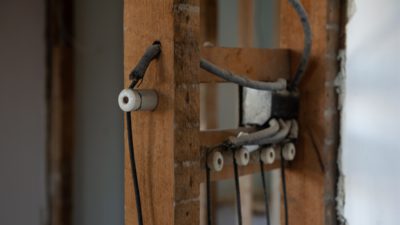For some people in New England, it constantly feels like there is a chill in their home. It doesn’t matter if they keep their doors shut and put plastic over the windows in order to block the drafts. Somehow, that cold winter air seems to slip into the house and keep everyone feeling chilly — regardless of how high the thermostat is cranked.
If this sounds like something you are experiencing, then the culprit may be a lack of insulation. In fact, your home may be lacking insulation in a few surprising places. Here are some of the hidden places where you may need some extra insulation in order to keep your home comfortable and reduce your heating and cooling costs:
The Attic
The attic hatch should also be insulated.
The attic is one of those places in the home that is often out of sight and out of mind. You may only head up there once or twice a year, perhaps to grab the holiday decorations. However, it’s one of the places that has a big impact on the comfort level of your home. When an attic lacks insulation, both hot and cold air can easily escape through the home. This drives up your energy costs and decreases the effectiveness and lifespan of your heating and cooling system because it is working harder to regulate the temperature in the home.
Adding insulation to the attic can help seal your home up tighter. Depending on the attic and what’s currently up there, insulation can often be added. HomeWorks Energy focuses on air sealing the top plate, which is the connection point of walls and ceilings, electrical penetrations, plumbing penetrations, and around ductwork. Warm air rises and escapes out of cracks at the top of the house, which why it’s critical to seal those areas. HomeWorks also builds small insulated boxes around recessed lighting in order to prevent heat from escaping into the attic in the winter. Once the attic is air sealed, the home energy specialist checks to ensure there are 12 inches of insulation on the attic floor. Places like the attic access point — whether that be a hatch, pull-down-staircase, or staircase – are also critical places to hit with insulation.
Cape style homes are popular builds in Massachusetts, and most have small spaces called knee walls, which are easy to overlook. Sometimes these alcoves have access points and sometimes they don’t. If they don’t have a pre-existing entrance, crews can cut a temporary one in order to gain entry. There are a couple of different treatments that can occur in these triangular spaces depending on the insulation that’s already there and if there is any piping in that space. Sometimes, an energy specialist will recommend insulating the knee wall walls, the floor, and the gable ends. Other times, the specialist will recommend insulating the attic slope and the gable ends. The crews would also insulate the attic hatch entrance. Recommendations are on a case-by-case basis, so it’s best to book a no-cost energy assessment and talk to a qualified specialist to see how to best improve the efficiency of your home. By adding insulation to your attic, you will find that your home is a more comfortable and affordable place to live.
The Basement or The Crawlspace
Many homes in New England have a basement and/ or a crawlspace, which should also be insulated. Crawlspaces generally have low headroom and dirt floors. Much like knee walls, treatment of these spaces can vary depending on what’s already there, such as piping. If the crawlspace has a dirt floor, the energy specialist will recommend installing a vapor barrier to prevent moisture issues from occurring. The specialist would then recommend either air sealing and insulating the perimeter of the crawlspace, or insulating the entire ceiling with fiberglass batting and foam board. Not only does adding insulation to your crawlspace help to keep the temperature of your home comfortable, but it also helps protect things like piping located in the crawlspace. This is particularly important in New England, where temperatures can dip well below freezing for most of the winter season.
The Garage
Residents who live in a home with an attached garage should consider adding insulation to this part of the home. It may be the place where you store your car or keep all of your favorite tools, but it also can be the spot where energy is being wasted. Insulation can be added to the interior walls of the garage, and air leaks can be sealed.
The Rim Joist
In unfinished basements, the rim joist is an important place to insulate. Cold air infiltrates into the home at the bottom of the house, warms up when it’s in the house, and escapes out the top of the house due to something called the stack effect. The rim joist connects the foundation and the ceiling in the basement. Connection points are naturally leaky, which is why it’s important that it’s air sealed and further insulated with foam board or fiberglass batting depending on the situation.
Fortunately, if you find out that your home could use some more insulation in one or more of these areas, the solution is relatively easy. A qualified home performance contractor, such as HomeWorks Energy, can recommend and install insulation into these spaces. Insulating your home using state programs that have money specifically allotted to making the adjustments affordable is one of the easiest home improvement projects you can have done. The results can often make your home more comfortable and save you money.
For more information on home insulation and to find out if your home is lacking insulation, contact HomeWorks Energy today to schedule your home energy assessment.








